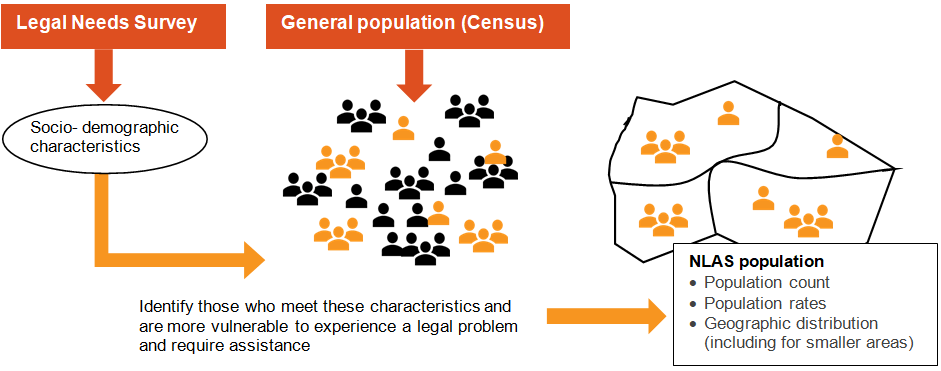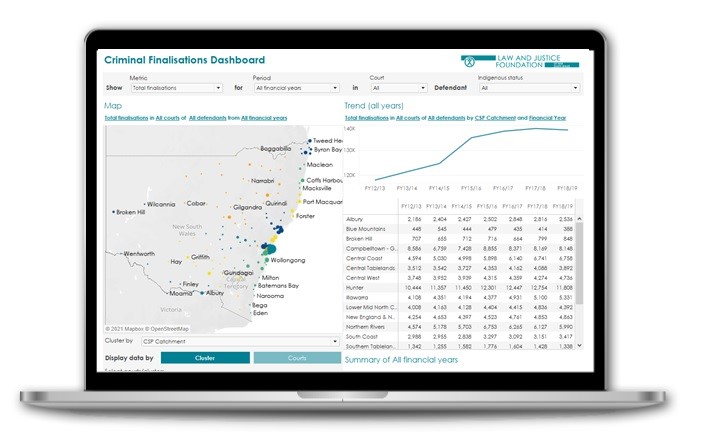What information and data sources are available to support reaching people most at need of legal assistance or most likely to access or interact with the justice system?

Knowing where potential clients live and access services can help the justice system and legal assistance providers identify accessible locations for courts, meeting spaces, offices, and outreach programs. For example, information on the geographic location of legal need can inform:
Locating legal needs to inform service delivery requires knowing where people who experience legal needs are, and what locations are accessible to them, at the times when the need arises.
Some specific types of legal need will be clustered in specific settings rather than where people live. This is the case for legal matters that are addressed in court settings, police stations, or prisons for example.
Population-wide legal need surveys generally only provide an overview of whether or not people access legal assistance and/or have interactions with the justice system. While this provides valuable information on who is and is not accessing services, and the reasons for this, more specific research/surveys conducted in particular geographic areas, for specific demographic groups, or local communities can provide more localised information on legal need.
Sources of information to support locating legal need in specific geographic locations include:
Locating legal need is also about understanding how best to reach particular communities to facilitate their access to assistance and the justice system.
The Australian Bureau of Statistics (ABS) Census provides reliable population counts in the smallest geographies.
This data can be used to profile specific geographic areas, or to identify in which geographic areas priority client groups are most likely to be found. For instance, Census data can be used to provide counts of:
The Foundation releases census data for relevant community groups and at various levels of geography in easy-access downloadable Excel spreadsheets. Click here to download the most recent resource based on 2021 Census data. Note the file will download directly to your Downloads folder.
The ABS Census data is also used to construct indices of disadvantage, such as the Socio-Economic Indexes for Areas (SEIFA). These indices describe the level of disadvantage of an area but do not provide a count of the number of disadvantaged people living in the area. This is important to bear in mind when considering potential demand, as some ‘advantaged’ areas may in practice include as many disadvantaged people as some ‘disadvantaged’ areas.
Although Census data is useful for locating specific socio-demographic groups it does not provide a ready count of how many people in a geographic area are likely to need publicly funded legal assistance, should they exprience a legal problem. To provide a measure that could be used to compare potential demand for legal assistance across geographic areas, the Law and Justice Foundation developed the Need for Legal Assistance Services (NLAS) indicators.
Legal needs surveys have identified the socio-demographic characteristics of people who are at greater risk of experiencing legal problems, and/or are more likely to need assistance to address those problems. By applying these socio-demographic characteristics to Census data, we can identify and locate the NLAS population: a count of people who are most likely to require legal assistance should they experience a legal problem.

The NLAS counts are not intended to be a precise measure of demand: legal need fluctuates over time and does not necessarily translate into demand for services. However, NLAS indicators provide a readily available proxy measure that is comparable across all Australian geographic areas and so can be used to assess relative potential demand between geographic areas.
The Foundation's legal needs dashboard is an interactive online data tool that helps legal assistance services and justice departments identify potential legal need in their areas. The concept of the dashboard is to allow users to explore different indicators and/or proxy estimates of legal need at various levels of geography.
In its first iteration in 2021, the National Legal Needs Dashboard was populated with 2016 Census data, social services data, and some NSW crime data. Following the release of 2021 Census data and upon feedback from the sector, the dashboard has since been reviewed and updated.
The Legal Needs Dashboard - Community Profiles 2023 now provides more recent data, new indicators, a streamlined interface, and improved overall performance. Data sources include the Australian Bureau of Statistics (2021 Census), the Department of Social Services, the National Disability Insurance Scheme, and the NSW Bureau of Crime Statistics and Research. Users can switch between multiple geography structures such as LGA, Statistical Area, suburb, postcode, and state/territory.
Locating legal needs at smaller levels of geography may require utilising various sources of information to provide a more complete and accurate picture than any one source alone.
Which data sources, the types of data, and how it may be used vary according to the purpose of the analysis: whether there is a focus on a particular area of law or problem type, or the planning exercise is for a specific provider or service type, or for a targeted population.
The Foundation’s Criminal Finalisations Dashboard is an interactive tool that allows users to interrogate Criminal Court statistics by court location in NSW.

Access the Criminal Finalisations Dashboard here.
Examples of other data sources include: